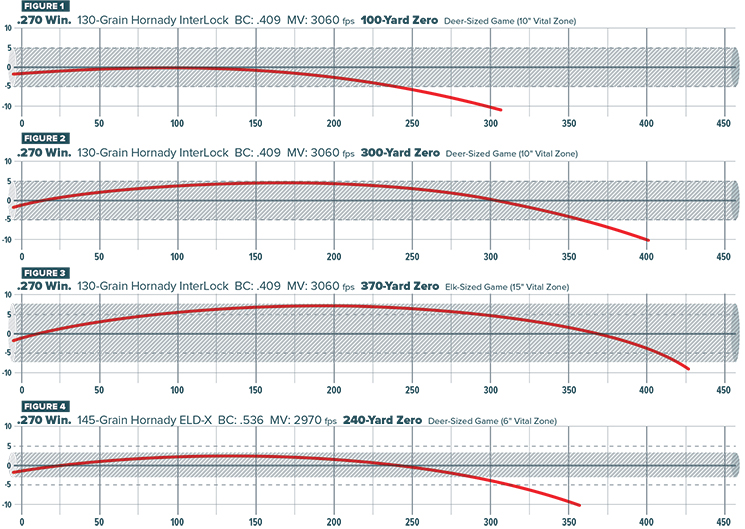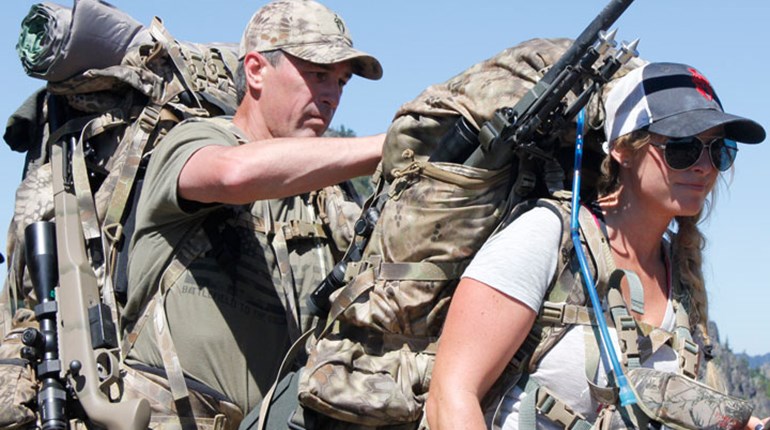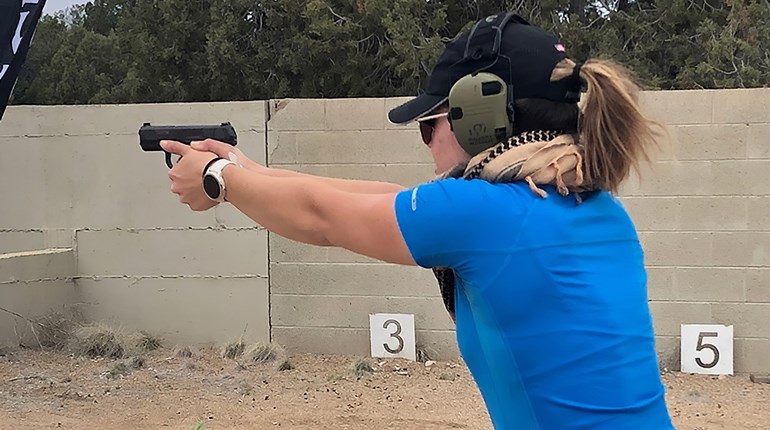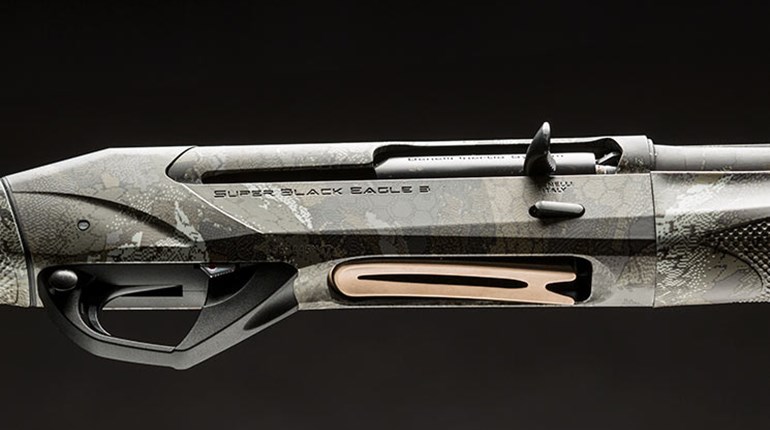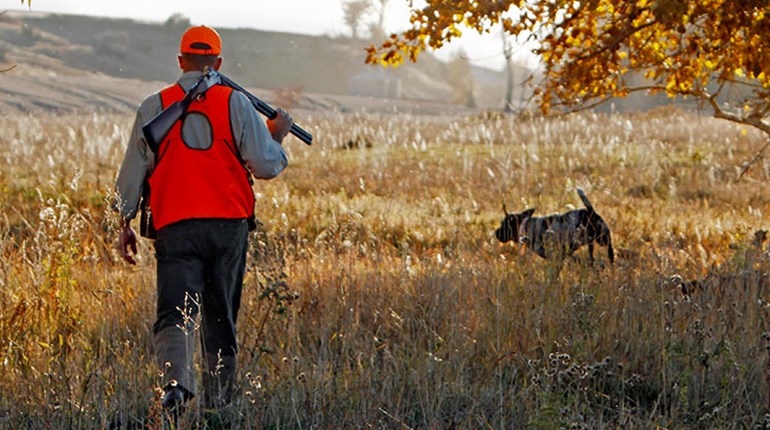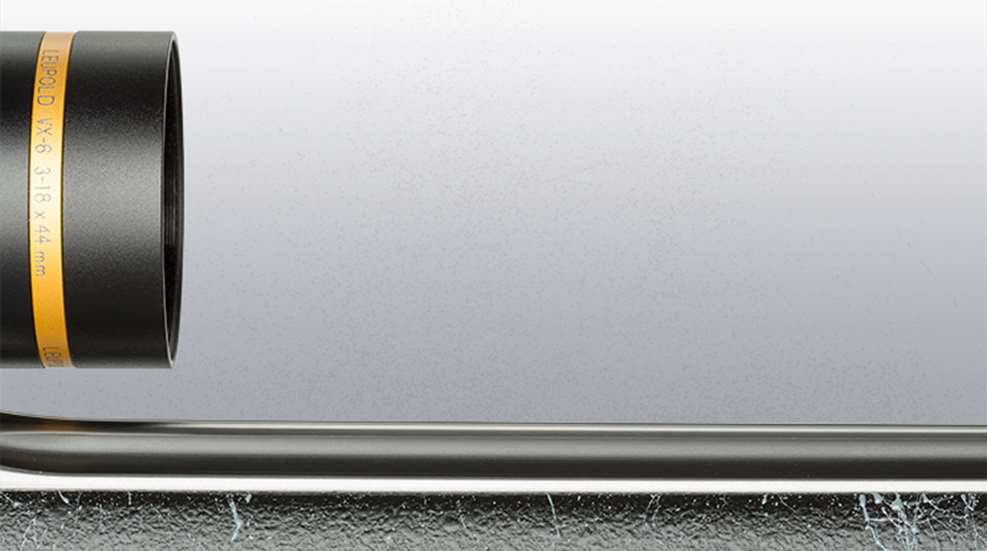
Jack O’Connor and Elmer Keith did it. So did Teddy Roosevelt and Dan Boone. Prior to the invention of the laser rangefinder, every hunter used the maximum point-blank range (MPBR) sighting system. It’s still the easiest, fastest way to take game out to 300 yards with modern centerfire rifle cartridges. All you have to do is aim dead on, shoot and fire up the grill.
With today’s super scopes, ballistic reticles and turret dialing systems, the old MPBR system might seem seriously outdated—until you factor in human nature. Technology has advanced, but we remain creatures of our evolution. With a buck or bull in sight, we still shake, sweat and forget how to push off a safety. Operating a rangefinder, calculating ballistic curves, turning dials and even selecting the third stadia wire down can be overwhelming tasks. With MPBR you can forget all that, hold dead on and score.
Stated another way, MPBR means you can hold dead center on an animal’s vitals (barring wind) and hit them from the muzzle clear out to 250, 300, even 400 yards. That’s farther than most of us ever have to shoot—or want to. We don’t have to measure or guess the exact distance. We don’t have to worry about holding over or under. We just aim dead center—and hit.
Three things determine how far downrange MPBR will work: 1) target diameter; 2) bullet performance—ballistic coefficient (BC) and muzzle velocity (MV); 3) zero range—the distance at which you zero your rifle to hit point of aim.
The easiest way to understand the MPBR concept is to imagine firing down a long pipe the diameter of your target. As long your bullet doesn’t hit the top or bottom of the pipe, you’re good. You adjust your sights to just miss hitting the top. Then the bullet’s MV and BC determine how far the projectile flies before striking the bottom. When it does, you’ve reached your maximum point-blank range. Simple.
MPBR works with any rifle, cartridge and bullet, but the faster and more efficient the bullet, the farther MPBR extends. Magnums were built for this reason. It wasn’t the extra punch so much as the extra reach that made them valuable in the pre-laser days. With the right magnum and high-BC bullet today, we can reach mule deer 400 yards away without holdover. With larger game, it can be much, much farther.
To illustrate, let’s set up a typical .270 Winchester whitetail/mule deer rifle. The average deer’s chest measures about 17 inches from backline to brisket. Within this lie the vital heart/lungs covering roughly a 10-inch circle. Some say 8 inches, some 12 because of the spinal column, but 10 inches is close enough. So long as we park our bullets within this 10-inch circle, winner, winner, venison dinner! To make this easy and prevent the need to know precise distance to target or guess holdover, we always aim for the vertical center of the vital zone. That is the key that makes MPBR so easy. The only thing we have to remember is to aim for center mass of vitals. The bullet does the rest. But only if we’ve set up our rig properly. (By the way, MOA accuracy isn’t required for this system to work. A 2-MOA rifle will keep all bullets within a 10-inch circle out to 500 yards. Of course, more accuracy is always better.)
Now, as we’ve all read, the .270 Win. shoots “flat.” What we haven’t read is the definition of “flat.” I can promise you, it does not mean “straight line.” Like all bullets, any launched from a .270 Win. begin to drop the instant they leave the muzzle. In order to get them to a target downrange we must angle our barrels slightly above our point of aim (POA). The faster the bullet and the less it drags, the less it drops. If we zero our scoped .270 Win. rifle at 100 yards with a 130-grain Hornady InterLock bullet (BC .409, MV 3060 fps), our bullet will start out about 1.5 inches below our POA (because the scope sits that high above the bore). Because our barrel is angled up slightly, the bullet will “climb” to hit POA at 100 yards. Then it begins to fall. At 200 yards it is already 2.9 inches below POA. At 240 yards it is 5 inches low. This means we’ve reached MPBR. At 300 yards it is almost 11 inches low (see Figure 1, p. 42).
But if we zero 3.6 inches high at 100 yards, that same bullet peaks 4.7 inches high at 175 yards, hits dead on at 300 yards and doesn’t fall below our 10-inch target until 355 yards (Figure 2). We can aim dead center on any deer and hit the vitals if it’s standing inside 355 yards. How easy can it get?
Whoa! Zeroing 3.5 inches high at 100 yards is a bit excessive, isn’t it? Well, not if our target is 10 inches. That’s 5 inches of leeway above and below POA. Hold for center and even at 175 yards the bullet stays inside the target zone. Admittedly, we graze the top edge at 175 yards, but that should still discombobulate the critter’s vitals. Nonetheless, this might be a “too-high” zero for other reasons, which we’ll outline in a bit. But first, let’s see what kind of MPBR we can enjoy with an elk for a target.
Elk are roughly 24 inches brisket to back. Figure the vitals cover 15 inches. That leaves a good 7 inches of room both above and below center. Zero 5.2 inches high at 100 yards and trajectory peaks 7.4 inches high at 200 yards, hits POA at 360 yards and is just 4.4 inches low at 400 yards. It doesn’t smack the bottom of our imaginary pipe until 420 yards (Figure 3). Now think about the 24-inch vital zone on an Alaska moose …
On paper this sighting system absolutely sparkles, but the real world tarnishes it a bit. For one thing, your rifle’s inherent imprecision can exceed the target diameter. An MOA rifle can throw any shot a half-MOA higher than normal. At 175 yards this adds almost an inch of additional elevation to a bullet already striking 4.7 inches above POA (assuming a 300-yard zero). You miss high if a deer’s vitals are your target. Then there’s the issue of shooter error. It’s one thing to shoot MOA from sandbags on a bench, quite another from field positions. Add an inch of shooter error to the above scenario and you’re really missing high.
Other anomalies one can expect afield are trajectory changes due to altitude, temperature, humidity and erratic winds. Mountains can create downdrafts and updrafts, adding additional inches to trajectory. All these extenuating circumstances suggest we scale back our vital zone diameters. This reduces our maximum point-blank reach, but there are ways to re-extend it: additional velocity and higher BC.
Adding velocity to any bullet extends its range. Improving its aerodynamic efficiency, enumerated as its BC, extends it even more. Check out how our .270 Win. shoots with a 145-grain, .536 BC Hornady ELD-X bullet fired at 2970 fps vs. the 130-grain InterLock fired at 3060 fps.
In Figure 4 above, I’ve chosen a conservative target diameter of just 6 inches and fudged even further by limiting the peak trajectory to just 2.6 inches above POA. Nevertheless, the ballistic efficiency of this bullet enables it to remain within the kill zone slightly beyond 275 yards. Increasing MV to 3100 fps would likely extend MPBR to nearly 300 yards. Of course, the .270 Win. isn’t likely to push a 145-grain bullet to 3100 fps. You’ll need a .270 magnum to accomplish that, which again brings up the real value of magnum cartridges.
If you wish to take full advantage of the old MPBR shooting system, you should be thinking about hot-rod cartridges and low-drag bullets. The 6.5-284 Norma, .26 Nosler, 6.5-300 Wby. Mag., 7mm RUM and their ilk are ideal for sending extremely long, sleek, high-BC bullets at high velocities. This results in such extended MPBR that you’ll probably never need a laser rangefinder again.
But remember the caveat. MPBR doesn’t work in the real world as perfectly as in ballistic calculators. Shooters are advised to reduce target size. Most deer hunters like to use an 8-inch circle when setting MPBR. The more cautious settle for 6 inches. Suit yourself. You can estimate to a remarkable degree MPBR with online ballistic calculators. Some specifically calculate the zero for MPBR after you enter MV, BC and target size. Regardless what zero range you establish, check it with live fire—and plenty of it. I like to set my scope to hit about 3 inches high at 100 yards. I then test it at 150 yards and 170 yards, usually the range of peak trajectory. Then a few shots at 300 yards give me a good feel for my maximum dead-on-hold distance.
Once I’ve done this, I shoot often and at varied ranges at a fiberboard box matching my chosen target size (10 inches). I use the same rests and hand positions I would when hunting. Sometimes hard rests make rifles shoot higher than normal, soft rests lower. These things are important to know, and range shooting is the way to discover them. Seeing bullet holes in a plain brown box I target from a multitude of distances cements my confidence in my rifle, my bullet and myself.
